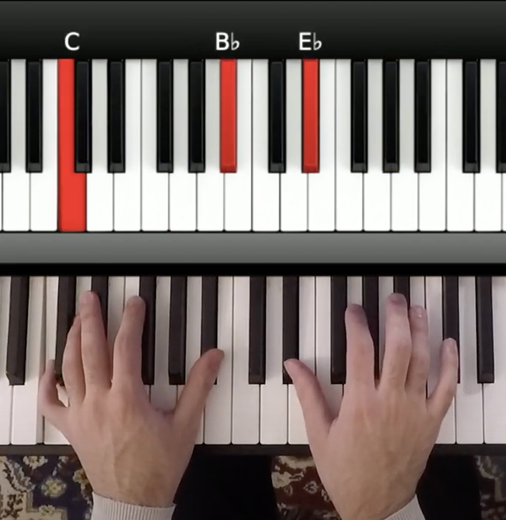Video Exchange Lessons
ft. Personalized Feedback & Assignments (with reference PDFs)
“A customized learning experience!”
|
I am now accepting a limited amount of students via my unique Video Exchange Lessons. This system is much more effective than in-person or zoom lessons. The Video Exchange Lessons combine the best of the live lesson experience with the best of an online course by including detailed feedback on your submissions as well as customized assignments, which include reference videos and PDFs. This is an experience and delivery not seen in the instructional marketplace. Email me directly if you're interested or to set up a FREE ZOOM meeting and lesson assessment where I can answer any questions about how the Video Exchange Lessons work.
|
|
|
BI-WEEKLY - $250/month
This is my most elite offering which will contain a full 2 weeks worth of lesson material. One can expect to receive maximum growth when using this program. Every 2 weeks you will submit your assignments by Monday morning (via YouTube link or Google Drive/Dropbox files) and by the Wednesday of that week I will send you a personalized 15 minute feedback video as well as additional assignment videos & PDFs from my library to match the lesson content. As a student working with this program, I am available for you via email with any questions you may have while practicing. We will become great friends as we work together and I can assure you full personal involvement with loads of information. MONTHLY - $125/month This plan works exactly like the bi-weekly plan however it is allowing more time to pass between lessons for those exceptionally busy people who want to make the piano a part of their lives but may have work or personal things that may not allow bi-weekly corresponding. |
How It Works
FREE CONSULTATION & ASSESSMENT:
I offer a free consultation to anybody interested in the Video Exchange Lesson system. I can answer any questions you may have about the system, assess your level and learn about your musical background & goals during this meeting. All levels accepted from beginner to professional musician.
PREPARE THE LESSON:
I then prepare your personally designed lesson.
BIJAN EMAILS YOU THE LESSON:
I then email out your entire lesson with videos of me playing all the content assigned to you. Your lesson consists of:
YOU PRACTICE:
You have 1 or 2 lessons per month. Practice as little or as much as you wish. Each month your workload may be lengthened or shortened at any time depending on your schedule.
RECORD YOUR LESSON:
Maximum submission 15 minutes in length. Email me your video submissions of the assigned material. Feel free to ask specific questions as well.
BIJAN LISTENS/CRITIQUES and CREATES YOUR LESSON:
Upon receiving your submissions, I listen to your entire recording and personally design your next lesson that is best suited to you.
I offer a free consultation to anybody interested in the Video Exchange Lesson system. I can answer any questions you may have about the system, assess your level and learn about your musical background & goals during this meeting. All levels accepted from beginner to professional musician.
PREPARE THE LESSON:
I then prepare your personally designed lesson.
BIJAN EMAILS YOU THE LESSON:
I then email out your entire lesson with videos of me playing all the content assigned to you. Your lesson consists of:
- A personalized video where I am speaking to you directly (15 mins in length). This is where I will highlight the lesson content, critique your submission playing and answer all your questions.
- Assignment Videos & PDFs. Each lesson will contain an assignment in each of the 4 areas: harmony, repertoire, improv and general
YOU PRACTICE:
You have 1 or 2 lessons per month. Practice as little or as much as you wish. Each month your workload may be lengthened or shortened at any time depending on your schedule.
RECORD YOUR LESSON:
Maximum submission 15 minutes in length. Email me your video submissions of the assigned material. Feel free to ask specific questions as well.
BIJAN LISTENS/CRITIQUES and CREATES YOUR LESSON:
Upon receiving your submissions, I listen to your entire recording and personally design your next lesson that is best suited to you.
The Benefits
MORE CONVENIENT
You never have to leave your home. Unlike an in-person lesson there is no fighting traffic and unlike a live zoom lesson there is no moving schedules to conform around lesson times. You are now able to have a professional pianist work personally with you in the comfort of your own home.
MORE FLEXIBLE
Feel free to practice as you find the time as little or as much as you wish. Again, you have the ability to have that lesson over and over again, a luxury any musician would love to have. This is what sets this method apart! It is far superior to an in-person or live lesson.
MORE THOROUGH
The Video Exchange Lessons System is more comprehensive than a live lesson could ever be. To watch your instructor play your entire lesson for you as well as having explicit detailed exercise PDF handouts would take a full day lesson. You now have both valuable resources available for your constant review, over and over again.
MORE AFFORDABLE
At only $125/month, the Monthly Video Exchange Lessons are much more affordable and more effective than weekly live piano lessons that may cost upwards of $75-$150/week.
IN CLOSING
This is an experience and delivery not seen in the instructional marketplace. Through this method, I determine where you’re at on your musical path and develop a step-by-step plan that systematically builds on top of each other. You’ll work hard, but you’ll never feel overwhelmed or lost. You get to experience the best of the live lesson experience with the best of an online course by including videos and PDFs from my library to match all the lesson content. And if you have questions, I am only an email away.
You never have to leave your home. Unlike an in-person lesson there is no fighting traffic and unlike a live zoom lesson there is no moving schedules to conform around lesson times. You are now able to have a professional pianist work personally with you in the comfort of your own home.
MORE FLEXIBLE
Feel free to practice as you find the time as little or as much as you wish. Again, you have the ability to have that lesson over and over again, a luxury any musician would love to have. This is what sets this method apart! It is far superior to an in-person or live lesson.
MORE THOROUGH
The Video Exchange Lessons System is more comprehensive than a live lesson could ever be. To watch your instructor play your entire lesson for you as well as having explicit detailed exercise PDF handouts would take a full day lesson. You now have both valuable resources available for your constant review, over and over again.
MORE AFFORDABLE
At only $125/month, the Monthly Video Exchange Lessons are much more affordable and more effective than weekly live piano lessons that may cost upwards of $75-$150/week.
IN CLOSING
This is an experience and delivery not seen in the instructional marketplace. Through this method, I determine where you’re at on your musical path and develop a step-by-step plan that systematically builds on top of each other. You’ll work hard, but you’ll never feel overwhelmed or lost. You get to experience the best of the live lesson experience with the best of an online course by including videos and PDFs from my library to match all the lesson content. And if you have questions, I am only an email away.
Testimonials
|
"I love my lessons with Bijan! The video correspondence format works great and each lesson is loaded with skills to work on, and tailored just for me. The lessons are well organized, and Bijan is always positive, encouraging and quick to answer any questions I might have along the way. Highly recommend lessons with him!"
- Carrie Selbee (Michigan) - Professional Pianist and Director of River City Music School |
|
"As an avid jazz enthusiast from a classical background, Bijan's jazz piano lessons have been transformative for me. Bijan combines a multitude of essential components like repertoire, improvisation, transcriptions, and most importantly, the language of jazz, into each lesson; something you just can’t learn from a book! The flexibility of correspondence lessons ensures I can learn at my own pace while still having the guidance and accountability of a personal teacher, and his teaching is high-quality tailor-made instruction to meet the individual needs of his students. As an active jazz pianist, he integrates real-world experiences into his lessons, sharing performances and insights from his peers, while staying accessible students and available to guide their work during the week."
- Dr. Benjamin Corbin (Virginia) - Assistant Professor of Piano and Collaborative Arts, Christopher Newport University |
|
"Bijan's lessons are the ultimate balance of customization and convenience. The instruction is focused on exactly what I need next, but it's delivered in a way that lets me learn at my pace and on my schedule. His blend of challenge and encouragement motivates me to reach the next level. A top-notch learning experience!"
- Ben Jackson (Washington D.C.) |
|
"Bijan is a gifted and passionate pianist and teacher. I have studied with Bijan for almost three years, have made great progress, and appreciate Bijan's attention to understanding my individual learning needs. He is consistently patient and encouraging. His teaching material is understandable and workable and keeps me motivated and inspired. If I have a question he also readily responds with a detailed answer. The correspondence/video format is the best and has advantages over in-person lessons. I can always go back and review the videos after initially viewing them and often find reviewing the videos again after I have worked on the lesson material for a while a plus. I can always access the previous lessons and pdf's as well. I think of Bijan as my portable teacher as I made a cross country move a year and a half ago and was still able to continue lessons. I started lessons with minimal jazz piano skills and more experience playing jazz on another instrument for over a decade, so I had to spend time working on the basics. Bijan made sure that I did not have holes in my playing with his ongoing attention to detail. Now I am playing at jam sessions and starting to play out more. I am very grateful that Bijan is my jazz piano teacher."
- Janette Greene (Pittsburgh, PA) |
|
"I feel very fortunate to be a student in Bijan‘s Personal Correspondence Lessons. The format he has developed for teaching Jazz Piano is unique in the field and works well for the student interested in working independently with the aid of a very knowledgeable instructor. Bijan brings with him a very strong skill set in all areas of both the theory and application of Jazz Piano. His lessons are very thorough and his knowledge is constantly shining through. The lessons are extremely organized with each one containing personalized videos, and accompanying PDF downloads, which include both Theory and Sheet Music applications. When you submit your videos to him, he responds with a totally personalized lesson. His vast knowledge and experience in teaching allows him to tailor each lesson to the correct level that you are at or should be progressing to. There is no cookie cutter approach whatsoever, and the time element that he spends on each lesson is extremely evident. It is obvious that Bijan loves sharing his knowledge and I strongly recommend studying with him should you wish to move ahead with your Jazz Piano abilities and enjoyment."
- Ron Meador (New York, NY) - Physical Therapist |
|
"I have studied with many different jazz piano teachers in the past, but Bijan is absolutely the best teacher I've ever had! Bijan is good at detecting what I need to work on and knows exactly what kind of practice helps me improve it. Also, I've never met any teachers as organized as Bijan. Bijan's assignments are well balanced and cover various categories that jazz piano players need to learn; repertoire, improvisation, harmony, and more. Each assignment comes with a professionally edited video and a PDF file. I can access all the videos and PDF files Bijan shared with me. That allows me to review old assignments anytime. Bijan always gets back to me with detailed and personalized feedback. Many times I felt like 'Wow, I never noticed that for years!' or 'None of my other teachers pointed that out!' I truly feel lucky to be able to study with Bijan."
- Yuki Shibata (New York, NY) - Professional Pianist & Educator |
|
My name is Glody Singa, I am a pianist in the Democratic Republic of Congo. I had always wanted to learn jazz piano, but until now I hadn't found a teaching method that suited me perfectly. Knowing that most pianists who offer the same services will lean more towards a one-to-one system, which is fine, but in terms of assimilation it can take longer. That's how I came across Bijan's page. His way of teaching is just great and suited my schedule and my ability to assimilate the lessons. Bijan is a very good teacher. His lessons are very well explained and easy to understand, especially as they are accompanied by a pdf that allows me to perfect my acquired notions. I used to have trouble with jazz improvisation, but thanks to him I'm doing really well. I can finally say I'm a jazz pianist.
- Glody Singa (Democratic Republic of Congo) - Math & Statistic Analyst |







